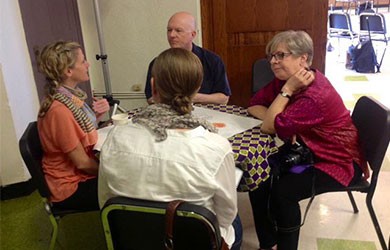Why We Don’t Have to Think Alike to Work Together
Originally published at Take The Lead
In May, I co-hosted a training in New York City, “The Art of Working Together with Open Hearts and Open Minds: Conversations That Matter.” My colleagues and I first ran this 2-day training back in February (you may remember the photo from our World Café conversation on difference) and decided to run it again since this theme of difference seemed to resonate with so many people.
Throughout the training (check out photos), listening to participants from all sectors share their stories of change-making, the words difference, duality, and multiplicity kept running through my head. Thinking about women’s leadership, I remembered a powerful piece I had read on Feministing.com by Samhita Mukhopadhyay “What can we do about feminism’s brand problem?” I love the title because with this alone, Mukhopadhyay highlights a potentially really important snarl. Maybe feminism or the women’s movement (whatever you want to call it) need not be a brand at all. Maybe our treating the women’s movement like a brand is part of what keeps us stuck or moving slower than we could be moving. Storytelling is essential to movement building, branding is not.
On this theme of difference, Mukhopadhyay writes:
“As much as it is easy to rest on the ‘equality between the sexes’ definition of feminism, if we really want to change the public perception of feminism, we actually have to change feminism itself. We have to both push for a world that demands gender equality, while pushing for a feminism that acknowledges, accepts, and truly incorporates difference.”
I suspect we are just at the beginning of learning how to work across difference. One question we explored in this last Art of Hosting training was, “What does it take to work with our differences instead of in spite of them?” So often we try to minimize, or better yet, wipe out our differences, or get people to agree with us, so that we can move forward together. But what if our desire to be on the same page is holding us back? What if in the women’s movement we could move forward together without being on the same page? What if we began our dialogues reminding ourselves that what we create together will be much more powerful and interesting than what we think we can create alone?
Beyond the Art of Hosting community of practice, I am encouraged to see projects and organizations dedicated to working with difference. Check out Living Room Conversations (co-founded by the founders of MoveOn.org and Tea Party Patriots) and the Interaction Institute for Social Change.
Working with difference may be difficult, but anything new and unfamiliar will be a challenge. If we can continue to name and make visible what we want to create together — a more just, gender-balanced world, where women hold half of the top leadership positions and have equal voice in society — then maybe working with difference will get easier and easier.
What differences do you see in the women’s movement? What shared beliefs and goals are you noticing?

